Quasars & Active Galaxies
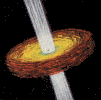

|
|
Gene Smith's Astronomy Tutorial Quasars & Active Galaxies |
 |

Quasi-Stellar Objects
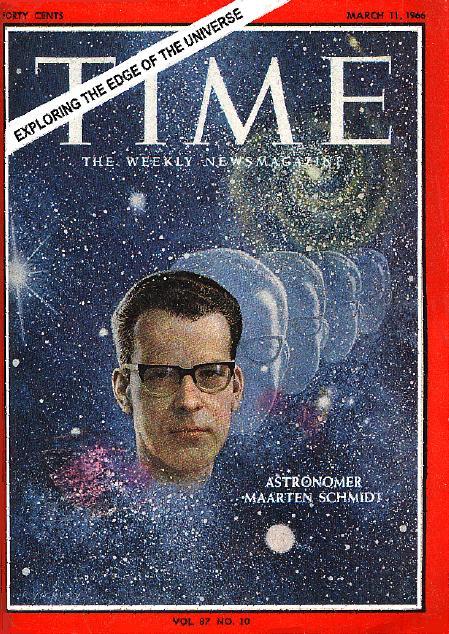 Astronomer Maarten Schmidt in 1963 | The first spectrum of 3C273 was obtained by Caltech's Maarten Schmidt using the Palomar 200" telescope. Schmidt puzzled over the photographic spectrum for months before he recognized that the strong, broad emission lines in the star were the familiar hydrogen-Balmer series, but redshifted by 15%. It was not the 15% redshift that had puzzled Schmidt, galaxies were already known with much larger redshifts, but rather the brightness of 3C273. 3C273 was a thousand times brighter than even a very luminous galaxy would appear at a distance of 2 billion light years, corresponding to a redshift of 15.8%. |

Soon even higher redshift quasars were discovered - there has been a longstanding tradition that the discoverer of the highest redshift quasar is awarded a case of champagne. For a time UCSD's Margaret Burbidge held the record. The current record Quasar has a redshift, z = 5.5 determined by astronomers at JPL and elsewhere, breaking a recent record, z = 5.0, from the Sloan Digital Sky Survey.
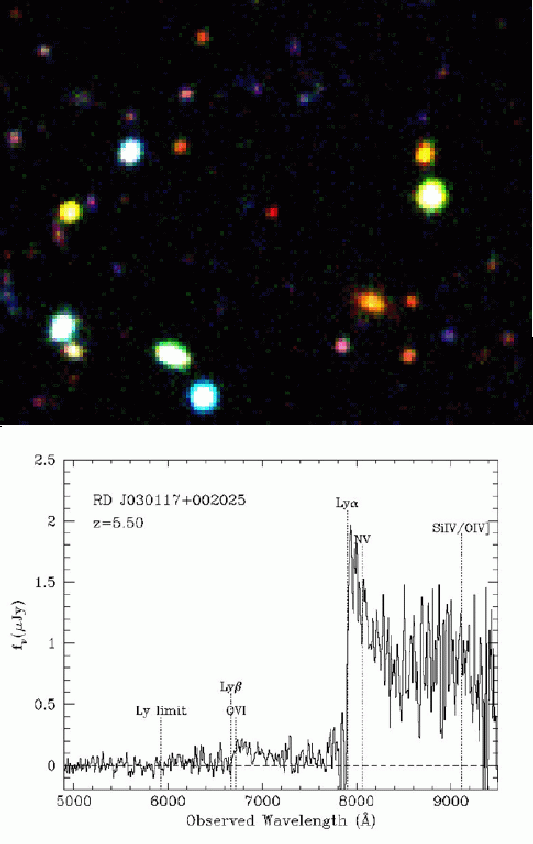
 is the n = 2 --> n=1 emission feature
is the n = 2 --> n=1 emission feature
A redshift of 5.5 (550%) corresponds to a velocity of 95% of the speed of
light, or a distance
of about 14 billion light-years. [The formula for redshift and velocity given
in the WebPage on Distances is only accurate
when v is much smaller than the speed of light; as
v  c
the redshift gets larger and larger such that the shift is infinite for v=c.]
c
the redshift gets larger and larger such that the shift is infinite for v=c.]
Quasar Variability and Size
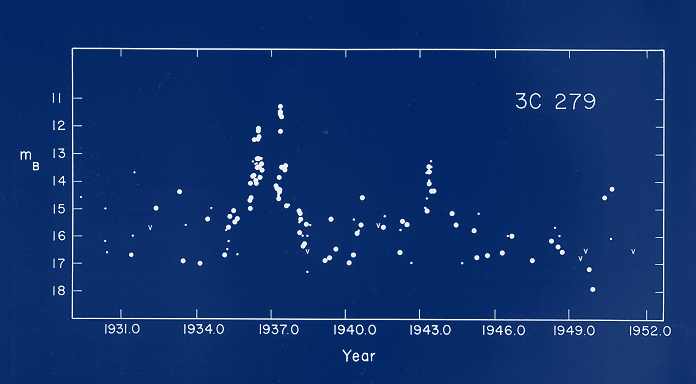
The large distances and extreme brightness of the quasars implies tremendous energy output; how do they do that? The question was complicated by the discovery that quasars vary in brightness, sometimes by huge amounts in periods as small as a week or so. There is a simple argument that the size of a variable, luminous object cannot be larger than the distance that light travels during its time of variation (i.e. if an object varies significantly in brightness over a period of a week, it cannot be larger than a light-week in size.
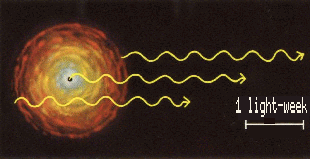 The Variability Timescale of a Quasar Limits the Size of its Light Emitting Region |
Suppose the "quasar" above flashed in brightness like a photographic flash. Light would begin travelling from all three points at the same time, but light from the center of the quasar would always be a light week behind light emitted from the front. Light from the center would reach an observer a week after detection of light from the front, and light from the back of the quasar would be detected another week later. This "flash" would be observed as a rise and fall in the brightness over a two week period. |
The variability of 3C273, 3C279 and other quasars requires that the quasar produce its luminosity greater than a thousand galaxies of billions of stars from a region smaller than our solar system!
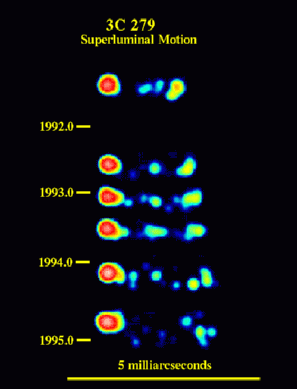 |
Superluminal Motion A further puzzle was provided when radio astronomers pointed global VBLI (Very Long Baseline Interferometer) networks with milli-arcsecond resolution at radio quasars. Every few years these quasars go through an outburst, apparently ejecting blobs of synchrotron plasma outward. When radio astronomers follow these outbursts, the blobs of radio emitting plasma appear to move outward at speeds that are sometimes as much as 10 times the speed of light. This phenomenon called superluminal motion or super-relativistic expansion suggests that quasars are violating the Special Theory of Relativity. No one believes this to be the case, and there is a straight-forward explanation which is consistent with Relativity. This explanation requires that the blobs of synchrotron plasma be shot out almost, but not quite, exactly toward us. |
Black Holes & Quasars
| Most astronomers believe that the most likely explanation of the tremendous energy output from quasars and small size is that quasars are powered by the release of gravitational energy from material falling into a massive black hole. The evidence that black holes inhabit the centers of massive galaxies is increasing. | 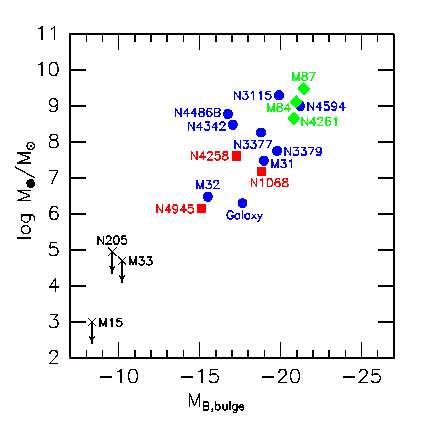 |
In this case Einstein's famous equation becomes:
which is to say that material falling into a black hole near the nucleus of a galaxy may release up to about 10% of its rest energy in the form of gravitational potential energy transformed into x-rays, relativistically moving particles, etc. which produce the phenomena that we see. Some astronomers speculate that stars which orbit to near the central quasar may be first puffed up by the intense radiation field, then tidally disrupted by the intense gravitational field, and finally pulled into a swirling disk of accreted material which will eventually be swallowed by the massive central black hole.
The release of gravitational energy by a massive black hole (about 100 million solar masses) "eating" one star per year would power a typical quasar.

![]() Active Galaxies
Active Galaxies
![]() Gravitational Lenses
Gravitational Lenses
![]() Education & Outreach
Education & Outreach
![]() CASS Home
CASS Home
Conducted by Gene Smith, CASS/UCSD.
Comments?
You may send email to hsmith@ucsd.edu
Prof. H. E. (Gene) Smith
CASS 0424 UCSD
9500 Gilman Drive
La Jolla, CA 92093-0424
Last updated: 29 Sept. 2000